Is a Repair to a Picture Frame in an Art Gallery in California Taxable
What to look for on the back of a painting — an expert guide
From its sale and exhibition history and provenance to notes from the artist on which way is 'Upward', the details found on the 'verso' tin significantly enhance a painting's value
one. Who, what, when... and where
First and foremost, you lot'll desire to know who painted your picture. Artists started signing their works around the 15th century, and while their signatures are most commonly on the front, in more recent times they take been practical to the reverse.
Christie's specialists can check signatures by looking them up in the creative person'southward catalogue raisonné and, sometimes, even narrow down the date a piece of work was painted based on the evolution of a signature over time.
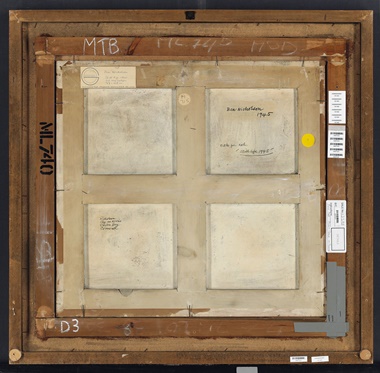
Nicholson's address in Cornwall has been added lesser left of the back of the picture
The artist volition ordinarily also take provided a championship or date. And sometimes more besides.
'Too as signing, naming and dating his works on the reverse, the British artist Ben Nicholson (1894-1982) often included his address,' says Christie'southward Modern British and Irish Art specialist Alice Murray. 'It's a lovely improver that helps you build the story backside the artwork.'
two. Materials can narrow downwards a painting's origins
Artists began switching from working on wooden panels to canvas in the 15th and 16th centuries because it enabled larger paintings. Painting on copper sheets also became fashionable in the 17th century.
Stamps and labels from the suppliers of these materials can contain the names and addresses of their businesses. Reference lists — such as Alexander Katlan's American Artists' Materials Suppliers Directory — can be used to runway them downwardly, and in plough, narrow down when and where a work was fabricated.
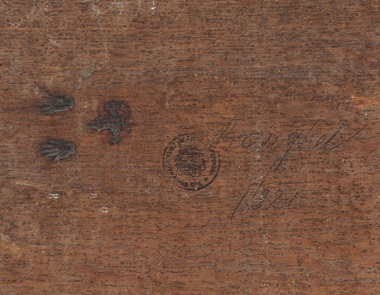
The reverse of a 16th-century oil painting panel showing the brand of the urban center of Antwerp — a pair of hands above a castle. The mark dates from 1617, when new regulations fatigued up by the Antwerp Joiners' Guild stated 'every joiner is from now on obliged to dial his marker on frames and panels made past him, on pain of a fine of three guilders'
Comparing the engagement the materials were purchased with the date the creative person signed the finished work can fifty-fifty requite you an thought of how long it took to complete.
The types of materials used to create a work's board, cradle or stretcher, forth with how it was constructed, also vary over time and between places.
Soft wood, such as poplar, was used in Italy, while hard woods, for case oak, was used in Britain and the Netherlands. Some other clue tin can be obtained from how the sheet is fixed to the stretcher — staples replaced nails after the 1940s.
3. Labels indicate provenance and exhibition history
When a gallery or museum displays a work of art it often attaches a label to its dorsum that indicates the creative person's name, the picture'southward title, and usually a date, inventory number and address.
'With the advent of the net it has become much easier to research these labels,' explains Impressionist and Modern Fine art specialist Veronica Scarpati. 'For example, the Museum of Modern Art has digitised all of its exhibition catalogues, press releases and lender lists as far back equally 1929.'
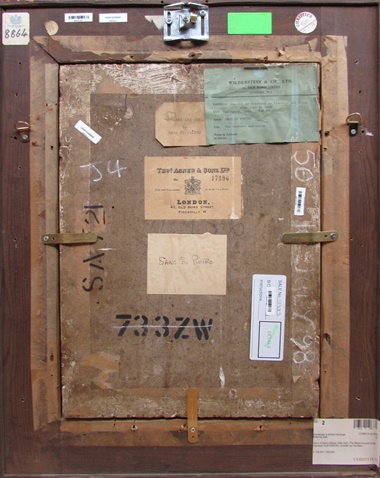
The back of Pietro's painting with stencils, stickers and labels, including those of London dealer Thomas Agnew & Sons and New York gallery Wildenstein & Co.
Other central players to look out for include institutions such as the Royal Academy or the Metropolitan Museum of Art, and dealers similar Richard Greenish, The Fine Art Gild or Wildenstein & Co., equally seen, top right, on the back of the picture shown higher up.
Other labels that record a painting'due south journeying can come from conservators, customs and border controls, or even defunct bureaucratic mechanisms such as the Nazis' Bedchamber of Culture, which stamped its double-headed eagle logo on to the back of the fine art it looted.
4. Inscriptions will also have a story to tell
Private collectors throughout history have added their own names to the back of a work. King Charles I of England (1600-1649), for example, branded his initials 'CR' topped with a crown onto the reverse of works in his royal collection.
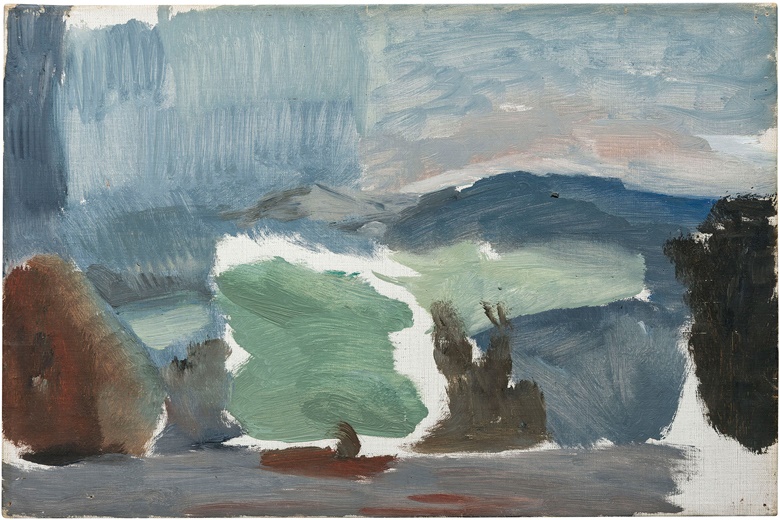
Ivon Hitchens (1893-1979), Hills and Darkening Heaven: Rain over the Downs. Oil on sheet. 12½ x 18½ in (31.vii x 47 cm). Sold for £32,500 on 23 January 2020 at Christie's in London. Artwork: © The Estate of Ivon Hitchens. All rights reserved, DACS 2020
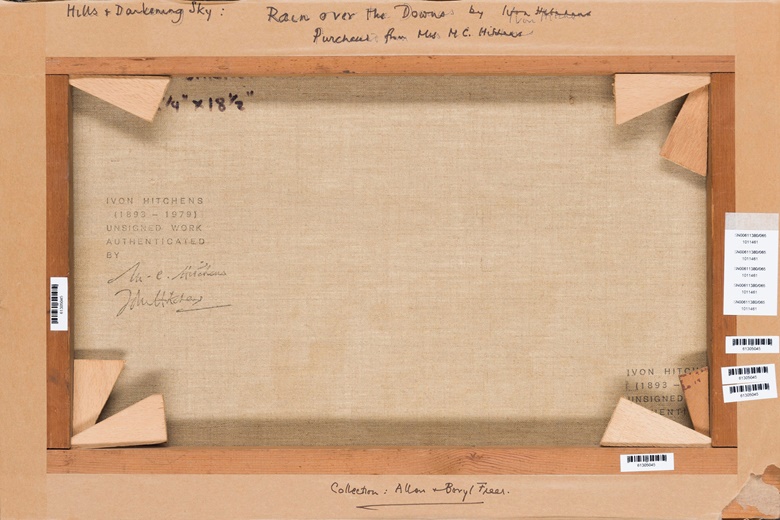
Allen Freer's handwritten provenance is on the bottom of the stretcher for Hills and Darkening Sky
'On the back of this landscape [above] by Ivon Hitchens (1893-1979) yous have the stamp of his married woman, Mollie, as well every bit a subsequently, handwritten note placing information technology in the collection of Allen and Beryl Freer,' explains Alice Murray.
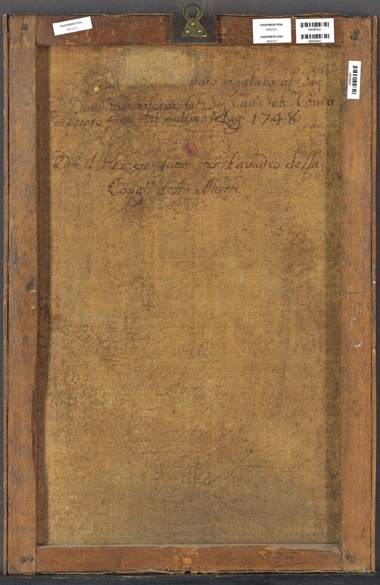
The dorsum of Conca'southward painting features a handwritten inscription indicating that is was gift to one D. Domenico Guastaferro
In 2019, Christie's sold a painting [above] past Sebastiano Conca (1680-1764), which contains an old paw-written note that describes its title, date and the fact information technology was a bozzetto — or sketch — for painting, as well as providing some provenance — that information technology was gifted to one D. Domenico Guastaferro in July 1748.
If you decide to add a support to the back of your painting, it might be an idea to use Perspex so that the labels remain visible, or ask a newspaper conservator to carefully transfer them onto the new board.
five. Inventory numbers reveal a piece of work'south auction history
Since the early 19th century Christie's has marked the back of pictures with an inventory number. Initially these numbers were stencilled in black ink, while other sale houses used chalk. (Today, rather than stencilling numbers on the back of pictures, it is more common for a sticker with a barcode to be practical.)
'These numbers correspond to records that tell united states of america when and where something was sold, and sometimes who sold information technology and what price was paid,' explains Christie's librarian and archivist Lynda Macleod. 'The Christie's archives in London has details of near of the sales held during the auction firm's 254 years in business.'
'When cataloguing paintings these stencils allow united states not merely to piece together provenance, simply also to run into if the work has been attributed to different artists in the past,' adds Olivia Ghosh, a specialist in Christie's One-time Masters department.
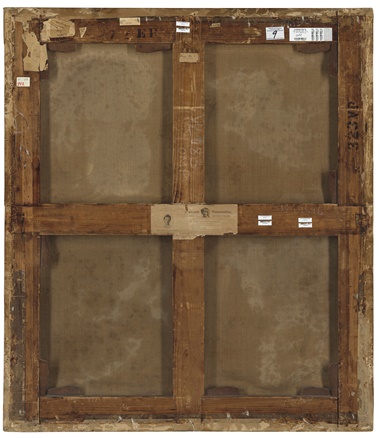
The reverse of Rembrandt's Man with a Sword showing its sale stencils, and in the centre, an 1898 Amsterdam exhibition label
In 2013, Christie's sold a portrait by Rembrandt (1606-1669)and his studio which had '272ER' stencilled on the back. 'That pointed the states to a 1928 sale at Christie's of a drove belonging to Sir George Lindsay Holford,' Ghosh explains.
'From there we traced the painting's provenance dorsum to his father, Robert Stayner Holford, who was the founder of the Burlington Fine Arts Club and owned iii other Rembrandts, all now in museums. Knowing these details can add peachy value to a painting.'
6. If the painting has been lined, repair piece of work may accept been carried out
If the rear of the canvas has traces of gum around the edges, or feels thick and new, the painting may accept been lined. This refers to the procedure of attaching an boosted layer of canvass to the original surface in lodge to repair holes and tears and stabilise the painting.
'Lining a sheet was, and nonetheless is, a common practise for Old Main paintings,' says Ghosh. 'In the past it was often done with a heavy hand, but now it tin can be completed without damaging the paint'due south surface.'
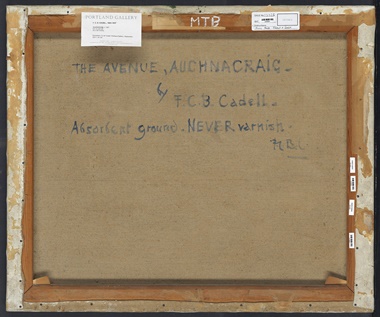
F.C.B. Cadell left clear instructions on the back of his works about how to care for them in the futurity
'The Scottish colourist F.C.B. Cadell (1883-1937) left clear instructions regarding how to maintain the condition of his works on their reverse,' says Alice Murray. 'On the dorsum of The Avenue, Auchnacraig [higher up] are the words "Absorbent footing/NEVER varnish", because Cadell felt the chalky quality of his paint surface was of utmost importance.'
seven. Warped stretchers tin exist a giveaway that it has been hung in humid conditions
Major cracks in the work might betoken that information technology has been hung in a hot, dry identify, such as higher up a fireplace, while warped stretchers could suggest it lived in a bathroom. 'Neither are advisable,' states Ghosh.
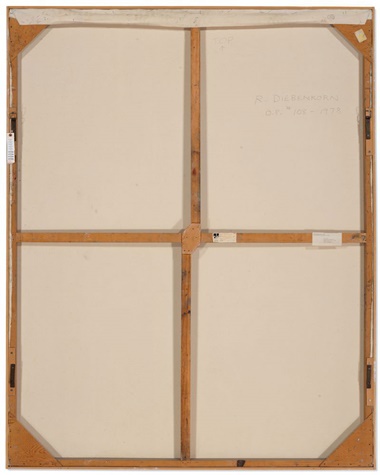
The contrary of Diebenkorn's painting helpfully explains which manner up it should exist hung
While non venturing so far every bit to specify where they should be hung, some artists, such as Richard Diebenkorn (1922-1993), helpfully exit notes to indicate their correct orientation. On the back of the work above Diebenkorn has written in pencil 'Height', with an arrow pointing upwardly.
Sign upward today
The Online Magazine delivers the best features, videos, and sale
news to your inbox every calendar weekSubscribe
8. On rare occasions, the back of a painting can even reveal another piece of work of art
Every now and again the back of a painting can reveal something that rivals the importance of the work of fine art on the front, such as a handwritten note by the artist —or even a 2d film.
'Materials take historically been expensive, so impoverished artists were known to try out different compositions on the same supports,' Ghosh explains.
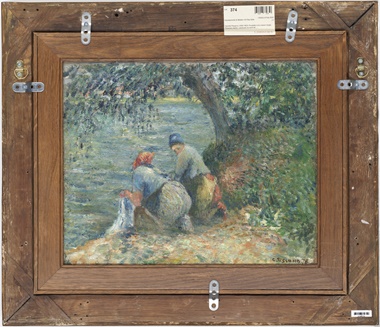
Set into the back of Pissarro's 1878 scene of farmyard birds is some other work entirely, depicting two women washing laundry
Veronica Scarpati proffers an example. 'In Feb this twelvemonth Christie's sold a work by Camille Pissarro (1830-1903) which had a 2nd, signed Pissarro on the opposite,' she explains.
'Christie's art handlers mounted it in a custom-made support then that both sides could exist seen during the auction preview. If it had been hanging on a wall, no i would have had an inkling of what the back was hiding.'
Source: https://www.christies.com/features/8-things-you-can-learn-from-the-back-of-a-painting-10293-1.aspx
0 Response to "Is a Repair to a Picture Frame in an Art Gallery in California Taxable"
Post a Comment